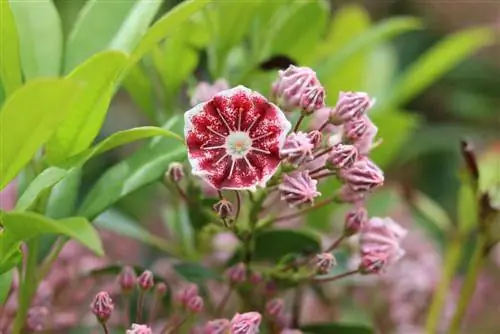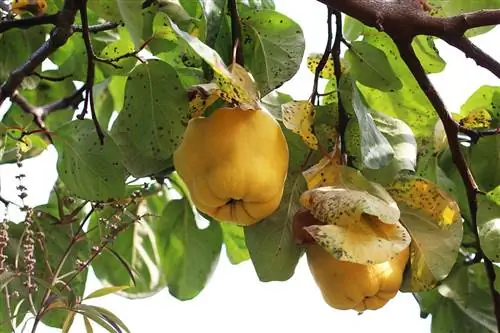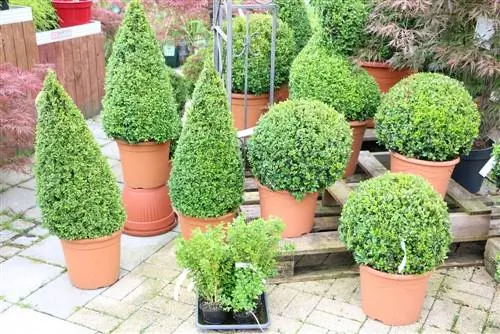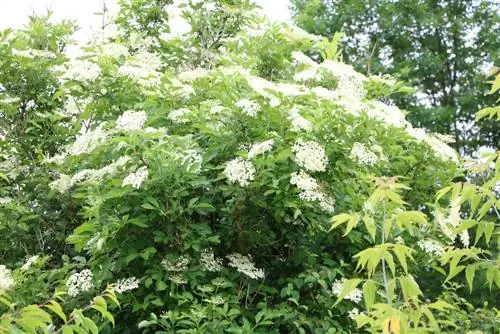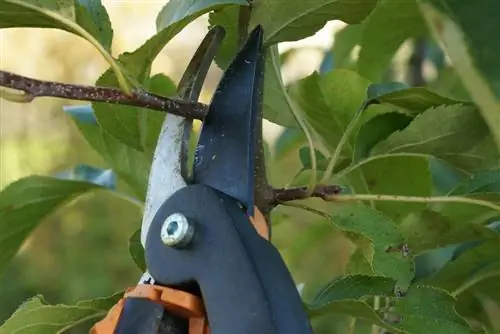- Author admin [email protected].
- Public 2023-12-17 03:39.
- Last modified 2025-06-01 06:48.
Trees belong in every garden, but they should match the size of the garden in terms of growth height so that a harmonious picture is created. Not an easy choice when the front yard just exceeds towel size. Among the ornamental trees for the front garden presented below, there is also a beautiful tree for such locations, and there is even quite a selection for the “normally small” garden:
Profile
- Woods (trees and bushes) give the garden its framework
- They are also the plants that will last the longest in the garden
- Not infrequently beyond the lifetime of the planting gardener
- Even if it is just a small ornamental tree because there is no room for large trees
- Selecting the right ornamental trees therefore requires time and careful consideration
- The article is about the different criteria that play a role in the selection
- Some less well-known ornamental trees are presented from each group
- Local and foreign, classically beautiful or surprisingly exotic
Local classics
When is a front garden usually planted? In many cases, after completing the construction phase of a home built by a young family, often both parents are working; Typically, only a very small portion of the available time is available for garden maintenance. The front garden should therefore be designed to be easy to care for, and so soon after construction it is certainly not a bad thing if the prices are quoted for the plants. Easy-care ornamental trees at affordable prices can be found among the native trees. The local prices are bearable because they develop in native soil without much effort (and are not grown in greenhouses with a lot of labor and energy).
Native trees are easy to care for because they grow in the exact soil and climate to which they have adapted over a long period of evolution. The development of our trees has been going on for around 200 million years (nosesperms=conifers) or a good 60 million years (angiosperms, most tree species); enough time to fine-tune your own organism to/with the environmental conditions. Voting means being able to survive in a particular environment without a gardener with fertilizer bottle or water hose in hand; If they are well rooted, the native trees only need care in extreme weather.
Tip:
The soil and climate to which a tree has evolved can belong to a narrow region. The sparrow, Sorbus domestica, is primarily a Hessian regional tree that used to play an important role in the production of Äppelwoi (it is currently being rediscovered, an interesting tree for not very small front yards/gardens). Today you will find a number of organic gardening businesses that produce regional speci alties such as: B. offer old apple varieties (which can possibly be easily kept in appropriate sizes by pruning). If there is an environmentally conscious nursery near you, it is definitely worth asking for regional trees.
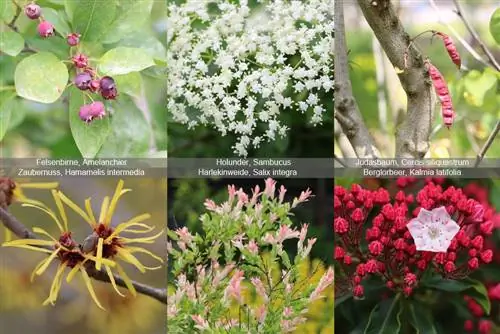
Overall, there are a considerable number of native trees, some ornamental trees are presented below, the size of which suits the front garden/small garden or can be easily made to fit by pruning. Some species have been selected here that are not mass-produced garden center products (garden centers often do not offer any native trees at all, but only quickly produced exotic cuttings that are not hardy or hardy) and that cannot be found in every tree nursery (or. are not offered in the front row because they are not part of the trends at the moment):
Rock Pear
The Amelanchiers genus produces beautiful ornamental trees in several species and varieties. Amelanchier ovalis, A. laevis, A. lamarckii (in the cultivars 'Ballerina' and 'Rubescens') are either native or have been naturalized here for centuries. The floury-sweet tasting fruits can be made into jam that tastes like apple and marzipan.
elderberry
The elderberry forms the plant genus Sambucus with almost 30 known species worldwide, three of which are native to Central Europe and two are suitable for small gardens:
Black elderberry, Sambucus nigra, the most famous elderberry, lilac berry bush, holler, holder. It is the supplier of elderberry pancakes and lilac berry jam, as a house tree it is said to ward off witches, fire, lightning and mosquitoes and can be cultivated as a multi-stemmed shrub or standard tree. If allowed, the Sambucus nigra will grow to a height of up to 10 m (in optimal locations, after several years) and be correspondingly sprawling. However, it is so easy to cut that you can easily solve any problem regarding “too much space taken up”: you simply cut the elderberry and a new elderberry sprouts from the root.
Red elderberry, grape elderberry, Sambucus racemosa, growth forms like black elderberry, remain lower overall (∅ 3 - 5 m). Very decorative bronze-colored to red leaf shoots, early setting of the pretty red spherical fruits, which are, however, slightly poisonous (stone kernels even after cooking).
Both elderberries are available in several cultivars, with attractive variations in leaf and fruit colors.
Judas tree
A little-known native small tree with the botanical name Cercis siliquastrum. Average heights between 4 and 8 m, surprising with the interesting peculiarity of the stem flowering, is sold in several cultivated forms with different flower colors from white-pink to dark red.
Tip:
When a property is planted for the first time after a house has been built, a layer of topsoil has usually just been applied to the compacted building ground; a real garden soil must first be created. The Judas tree helps by entering into a symbiosis with bacteria as a so-called legume, so nitrogen from the air can be converted into a form that is available to plants.
Cherry laurel, cherry laurel
The well-known front garden classic is Prunus laurocerasus, the common laurel cherry, impressively beautiful, undemanding and easy to cut, maximum height of 6 m, but also available as a 1.50 m standard tree. Contrary to widespread belief, the laurel cherry is not a native tree; instead, as an import from the Middle East, it is already endangering the native nature in some regions of Germany through invasive release into the wild. In these regions the laurel cherry is no longer recommended for planting; The even more frost-hardy Prunus lusitanica (Portuguese laurel cherry) is available as a replacement, but only a few native insects and birds fly to it. With an average height of 5 m, it is a great evergreen tree for the front garden, but for ecological reasons it should only be planted in the company of native trees in more remote locations.
Row ash (Sorbus aucuparia), common lilac (Syringa vulgaris) and holly (Ilex aquifolium) are rarely seen at the moment. All of these ornamental trees do not need to be watered when there is normal rainfall and, in a location with normally nutrient-rich soil, they do not need to be fertilized (a little compost or a layer of mulch on the roots is of course always okay, it is simply part of soil care).
Proven guests from foreign countries
If you want a piece of garden to have a very special look, the garden center offers lots of unusual ornamental trees that are actually native to distant lands. The following are some smaller ornamental tree species that have already proven sufficiently that they can cope well with our climate:
Chokeberry
Aronia melanocarpa comes from the northeastern USA and has shown itself to grow so robustly and he althily in our country that it can, for example, B. has been grown in Saxony and Bavaria for decades. The chokeberries are very he althy and can be dried, made into jam and juice.
Maple
Maple trees are v. a. A beautiful eye-catcher with their magnificent autumn colors, but in the three native species sycamore maple, field maple and Norway maple, they reach heights of mighty 20 to 30 m, and are not trees for small gardens. Around 200 species of maple trees grow all over the world, some of these species can be cultivated here as frost-hardy, small ornamental trees:
- Japanese Japanese maple, Acer japonicum 'Aconitifolium', is only 3 m high, grows slowly and can be kept small by pruning
- French maple, wine maple, castle maple, Acer monspessulanum, pretty small tree with an average final height of 5-6 m and unusually shaped triangular leaves, whose autumn colors create a vineyard atmosphere
- Golden maple, Acer shirasawanum, with great colors, a maximum height of 3 m and slow growth, the perfect maple for the front garden
- Fire maple, Acer tataricum subsp. ginnala, super autumn red and extremely cold-tolerant, grows to a maximum height of 6 m
Mountain laurel
Kalmia latifolia grows as a small evergreen tree (originally in the eastern USA) with heights between 2 and 8 meters. Raceme-shaped inflorescences with up to 40 flowers each from April to June, hardy down to USDA Zone 4a (max. -34.4 °C); Overall, a particularly beautiful ornamental tree.
Flowering cherry
The Japanese flowering cherry Prunus serrulata is an ornamental cherry that has long been known all over the world. In temperate climates (in our country) there are so many pink flowers in all locations with lots of sun that you can celebrate your very own cherry blossom festival.
Harlequin Willow
The harlequin willow, Salix integra 'Hakuro Nishiki' comes from East Asia and is really colorful like a harlequin with its white to pink young shoots and variegated leaves. Hardy from winter hardiness zones 9 to 4 (-3.8 to a maximum of -34.4 °C, definitely enough for Germany), growth heights up to 2.5 m, also as a grafted standard tree: a very tree with its very own expression, de.wikipedia.org/wiki/File:Salix_integra_a1.jpg.
Katsura tree
The Cercidiphyllum japonicum also comes from Asia, grows slowly to 8 to 10 m high, but thrives better under vigorous pruning and can therefore be kept at any height. The Katsura tree provides changing color plays in autumn and, as a special surprise, the smell of gingerbread, cinnamon and caramel, so visitors are rarely welcomed into the front garden (young plants need winter protection in regions with unfriendly climates).
Magic Haze
The witch hazel is a plant genus with five species, three are native to eastern North America and two to eastern Asia. All pretty little trees whose delicate yellow, orange and red flowers with a pleasant scent usually appear in winter before the leaves emerge; only Hamamelis virginiana blooms in autumn.
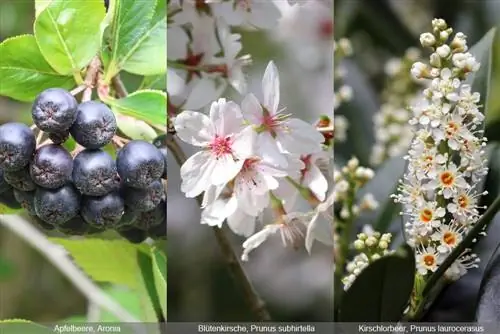
Special offers from the ornamental plant industry
If governments would act as quickly as for-profit companies open up new earning opportunities, we would have no gentrification and no shortage of affordable housing in our cities. Unfortunately they don't, but retailers noticed very early on that the living space for normal earners was changing. a. in German cities tends to move towards tiny for cost reasons, and a number of new products are developed.
Columnar hibiscus, mini almonds, mini mirabelle plums and the dogwood Germany tree with a black-red-gold braided trunk find a place in the smallest front garden and in the tiniest garden, duo fruit trees apple, sweet cherry, plum and the dwarf Peach 'Bonanza' promises a rich harvest even on the 2 sqm balcony. Never higher than 2.5 m, in the photos it is covered in flowers or fruits so that the leaves can hardly be seen.
That's exactly the problem with the wondrous miniature fruit and balcony bonsai: They are often so overbred and sensitive that the promised result can only be achieved at consistent temperatures of 23.7 °C, 642.7 hours of summer sunshine, watering with 416 l of water and fertilizing with 0.475 l of liquid fertilizer per season. What you can only partially influence and only find out after a few years of testing; By then, the miracle plant is often a thing of the past because it reacts extremely sensitively to any deviation from the desired treatment.
Tip:
Conifers can also be found among the guests with foreign origins, quite a few in fact. These were not included here because they can contribute little to an overview of basic garden design with small ornamental trees. Because today no one will design a garden with foreign conifers alone: even the few native conifers only feed a very limited selection of insects, imported trees with needles are a total failure for the insect world.
The very special ornamental tree
If you want to redesign or add to your front yard/garden because the existing design has been serving it for many years and is now a bit boring, easy maintenance is probably not the determining design criterion. It's probably more about making something very special out of the front garden as part of the redesign.
This very special ornamental tree comes from the tropics or the Mediterranean region and still does well in the German garden. With a view to ecological balance, it should be cultivated as a solitary plant surrounded by native plants; This works well if you want to plant a real eye-catcher in the front garden:
- Chinese hemp palm, Trachycarpus fortunei, the front garden palm for moist, partially shaded locations is hardy down to -15 °C
- Japanese camellia, Camellia japonica, evergreen shrub with decorative spring flowers, hardy to -23 °C
- Asian lotus tree, Clerodendrum: C. bungei and C. trichotomum, hardy down to -23 °C, 3 to 4 m high, interesting white/red flowers
- Opuntia, Cylindropuntia imbricata, grows up to 3 m high and can withstand -25 °C in dry locations (front garden for cactus lovers)
- Asian silk tree, Albizia julibrissin, around 6 m high, tropical-looking red fluffy flower, can withstand winter cold down to -23 °C
- Yuccas, South America: Yucca glauca hardy to -35 °C, Y. flaccida, gloriosa, filamentosa + recurvifolia to -25 °C
- Dwarf palmetto palm, Sabal minor from the south of the USA, slow growing palm, hardy to -17 °C
- Dwarf palm, Chamaerops humilis, grows in the Mediterranean and is also hardy down to minus 15 °C (protected against a south wall)
The winter hardiness information only applies to strong, adult specimens; Young, not yet fully established plants always need winter protection.

